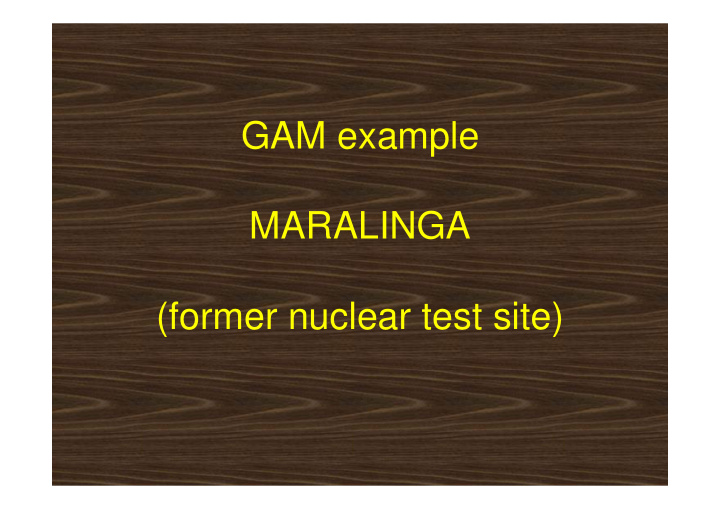



GAM example MARALINGA (former nuclear test site)
General remediation methodology • Site characterisation • Risk assessment • Establishment of cleanup criteria (goals) • Cleanup • Verification 1
Nuclear tests in Australia • 1952 – first British atomic bomb explosions at the Monte Bello Islands off the WA coast • 1953 – Britain conducted two atomic explosions at Emu in SA • 1956 – two more tests at the Monte Bello islands • 1956 -1957 – Britain conducted seven atomic explosions at Maralinga. • 1957 – 1963 – hundreds of “minor trials” were also conducted at Maralinga, contaminating the environment with plutonium and other radioactive debris. • 1966 – first cleanup by British – operation “Brumby” 2
3
Maralinga – 1980 to • Operation Brumby was supposed to have left the Maralinga site in an acceptable condition • Preliminary studies by the Australian Radiation Laboratory (ARL) during 1984 and 1985 indicated that contamination levels were significantly higher than previously reported • A technical assessment group (TAG) was set up by the Australian government in 1986 to oversee further technical studies of the site and to advise on rehabilitation options • More detailed studies in the late 1980’s showed extensive contamination by plutonium over well-defined plumes corresponding to the wind direction at the time of each minor trial 4
5
Site characterisation • Most of the contamination was still within 10-20 cm of the surface (low rainfall) and consisted of three components – Fragments of plutonium-contaminated debris (visibly identifiable) – Finely divided material (potentially inhalable), consisting of grains of plutonium oxide or contaminated soil - more or less uniformly distributed – Sub-millimetre “hot” particles of soil or other material, randomly distributed • Many of the fragments had already been placed in 22 burial pits which were capped with concrete 6
Stakeholders • Australian Government • South Australian Government • Maralinga Tjarutja people • Pastoralists • Tourists • Radiation Protection Community 7
General Approach • In 1993 the Maralinga Technical Assessment Committee (MARTAC) was established to evaluate the risks and determine acceptable cleanup criteria – this committee included experts from Australia, the USA and Great Britain • The initial MARTAC assessment established that the group most at risk would be indigenous people passing through and camping (and possibly hunting) on the site • The risk assessment was based on a study of the diet, habits, etc., of these people • The exposure pathway of greatest concern was found to be inhalation of dust by children playing around camp sites 8
9
Cleanup criteria • Maximum dose of 5 mSv per year to any individual, for full-time occupancy by indigenous people living an outstation lifestyle – this corresponds to a risk of fatal cancer of 1 in 10,000 by the 50 th year of life • The final cleanup criteria were chosen to enable this dose constraint to be met: 1. A maximum concentration of plutonium per square metre in finely divided material 2. A maximum number of particles per square metre 3. Visible fragments to be collected 10
Cleanup procedure • The top 10-20 cm of soil was removed by scraping • This material was placed in burial pits and covered with 5 m of clean soil • 11 of the burial pits were treated by in-situ vitrification (ISV) – material from the remainder was exhumed and placed in another large burial pit 11
12
Radiation protection issues during the cleanup • The main health physics problem was inhalation of plutonium attached to airborne dust particles – dust suppression was achieved by spraying water on the haulage routes • A strict health physics regime was applied to all personnel working in the contaminated areas to minimise the probability of inhalation or ingestion of contaminated material – Strict hygiene rules – Measurements of contamination on hands, clothing, etc – Personal decontamination where necessary • Vehicles were checked before being allowed to leave contaminated areas to minimise transfer of contamination 13
14
Verification • Purpose of the verification measurements – to show that the cleanup criteria had been met • Two measurement systems were built by ARL in the early 90’s, corresponding to the need to verify the two main cleanup criteria – Average plutonium concentration per square metre – Number of particles per square metre • In addition, measurements of plutonium in suspended dust were made to check that the airborne concentrations of plutonium were at acceptable levels (Lawrence Livermore National Laboratory and ARL) • The verification process was carried out while the site was being cleaned up 15
16
17
Was the cleanup successful? • A post-cleanup assessment suggested that the estimated doses after remediation were a factor of approximately 5 lower than the doses on which the cleanup criteria were based • The procedures developed and used at Maralinga have been used and/or adapted for similar situations in other countries 18
Recommend
More recommend